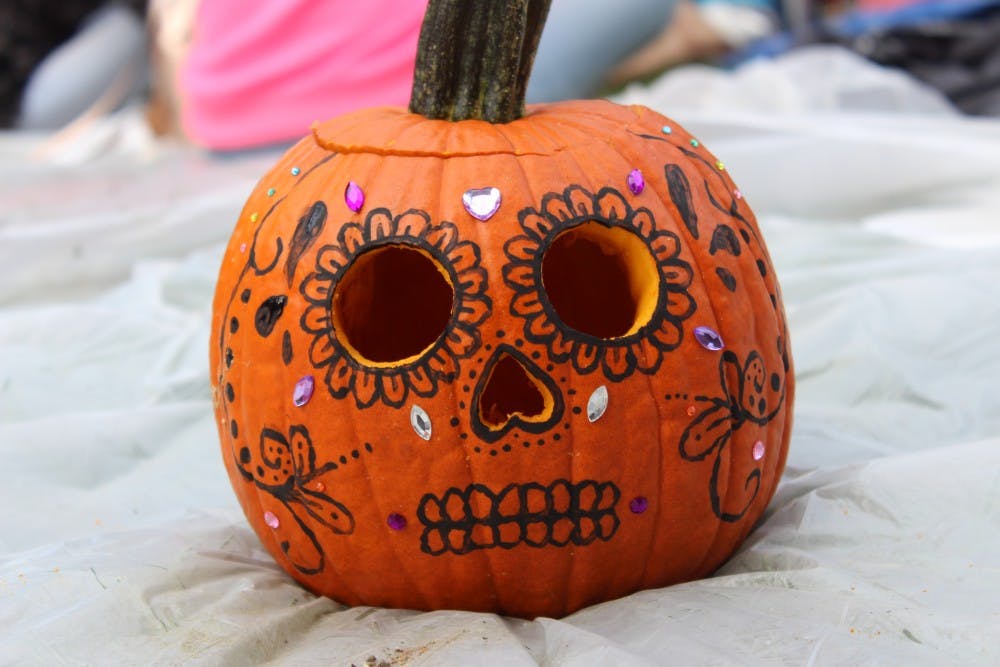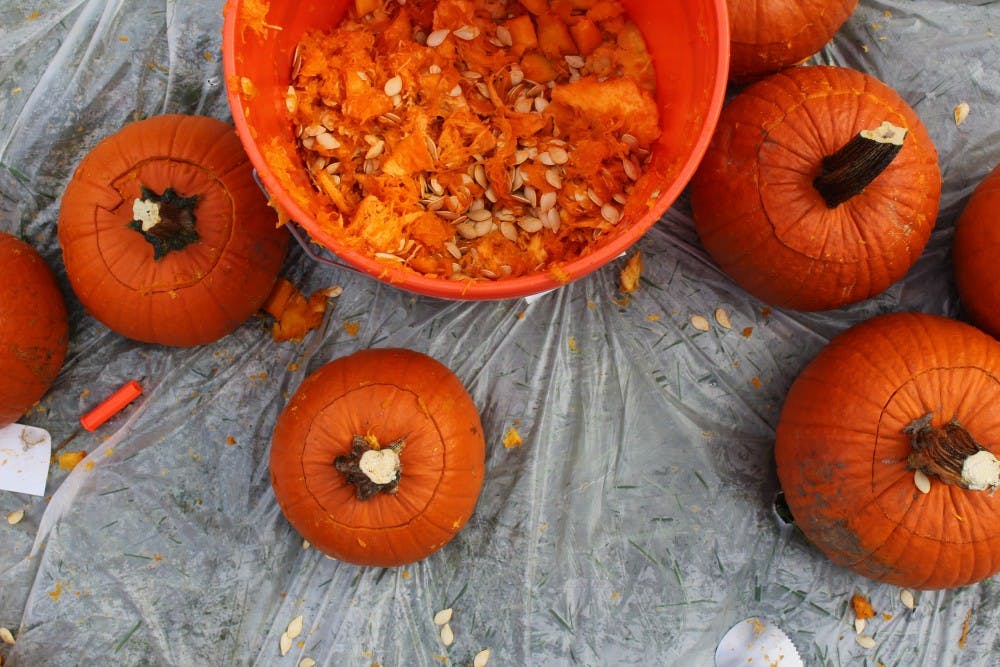
On Saturday, October 20, nearly thirty refugees, alongside Princeton students, faculty and their families took a break from their jobs, studies, and otherwise busy lives to participate in the Office of Religious Life’s annual pumpkin carving event. Crouched on tarps on the Murray Dodge lawn in the cool afternoon air, participants immediately took to carving, painting, and decorating what soon became a beautiful and diverse array of pumpkins.
According to Dean Matthew Weiner, or “Dean Matt,” one of the deans of the Office of Religious Life and the main organizers, the event began three years ago when a group of students who worked with refugees over the summer wanted to continue their service by connecting with refugees in the Princeton area as well. To facilitate this, Dean Matt called Patrick Barry, Director of Refugee and Immigration Services at Catholic Charities in Camden, who works with refugees as soon as they arrive in the United States.
“From the moment their toes touch the ground, we pick them up from the airport, help them get housing, employment, get them enrolled in school, make sure they have all their medical checkups, and after that generally we provide overall support as a whole,” Barry explained. He was delighted at the opportunity to provide refugees with an opportunity to experience American culture.
Originally intended as a singular activity for a specific group of Princeton students and refugees, the concept of pumpkin carving with refugees in the area blossomed into an all-inclusive annual event, co-sponsored by that year’s sophomore class in conjunction with the Office of Religious Life under its Religion and Forced Migration Initiative.
In addition to introducing refugees to an American tradition, pumpkin carving gives them a taste of Princeton life by acquainting them with Princeton students and faculty. The carving takes place right on McCosh Walk, which students frequent on their way to class, meals, or study sessions in Firestone.
“A lot of these families come from places where education is a luxury from the very beginning, where literacy is not as common as you would have hoped,” Barry said. “We try to emphasize to them the opportunities of education and higher learning; what better place than this beautiful campus of Princeton?”
When asked about the faith-based nature of the organization, he answered, “It is a Catholic organization, but we are non-discriminatory; we serve all vulnerable individuals irrespective of creed, color, religion,” adding, “Right now, there’s a lot of mischaracterization of immigrants and individuals seeking refuge and asylum. Catholic Charities has been very active in the community, raising awareness about some of these issues.”

During the event, I had the opportunity to speak to two teenage refugees, Mehvish and Nimra, originally from Pakistan. Mehvish has lived in the United States for four years, Nimra one year and six months. Mehvish is in her second year of college, and intends to become a doctor. Nimra is a junior in high school and is undecided about her future career. When asked about how they met, Mehvish replied that they attend the same mosque here, adding, “Any event that happens, we get together in the same place.”
Neither of them had ever experienced anything like pumpkin carving before and agreed that it was difficult but enjoyable. According to Mehvish, they prefer to eat pumpkins in Pakistan rather than decorate them, although Nimra said she had never eaten pumpkin before either. Mehvish and Nimra appeared untroubled by their lack of experience as they immersed themselves in carving and decorating some serious pumpkins.
While the event centered around refugees, its true focus lay in inclusivity. “Our idea is to turn around and see who’s around us,” Dean Matt explained.


Silma Berrada ‘22
Saturday’s encounter had an artistic side in addition to a spiritual one, though some might argue that those are two sides of the same coin. Director Jane Cox attended the carving with members of the cast of “The Odyssey,” which Cox described as “a community theater project that’s going to be the biggest project the theater program does this year.”
Headed by Victoria David John ‘19, “The Odyssey” brings Princeton students together with multiple community groups such as the Trenton Children’s Chorus, Trenton Circus Squad, and Homefront, an organization that helps home insecure and homeless people in the area. Alongside Princeton students, members of these groups will perform as part of the cast as well as help create the set.
When asked about the relationship between the pumpkin carving event and the production, Cox replied, “Because the Odyssey is sort of the ultimate migrant story, we thought it would be a great opportunity to highlight migrant stories.”
Pumpkins that people didn’t take with them on Saturday were displayed by the reflecting pool outside the Lewis Arts Center along with signs explaining their significance.
The signs listed the countries that their creators come from, both refugees and students’ families alike, “to highlight the shared nature of everyone’s migrant stories,” Cox explained.
Both Saturday’s pumpkin carving and the production of “The Odyssey” encourage students to take a moment to look beyond the routine of Princeton classes, Princeton extracurriculars, and Princeton social activities that can easily become their entire reality.
Professor of History Yair Mintzker, who attended the event with his family, remarked that “Princeton can often be a bubble, an ivory tower, literally, and it’s important to remind ourselves that there are people out there who need our help.” His advice for Princeton undergraduates is “to take the time away from their busy schedules and realize that there are people out there who need to be seen.”

Dean Matt pointed out that the current political climate has made it more difficult for refugees in this country in recent years, and for this reason “any opportunity to welcome them is an act of service and justice.” Now, perhaps more than ever, we need these gestures of welcome, these acts of reaching across divides.
When asked if any themes of the event intersected at all with his work, which focuses on early modern and modern German history, Mintzker said simply, “Any good work in the humanities is about the human condition.” He felt that the event had little if anything to do with faith, despite its relation to the Office of Religious Life and Catholic Charities. “It’s about being a human being.”
Regardless of whether or not spirituality played a role in Saturday’s festivities, the event brought people from at least eight different countries, young children and parents, students and teachers, from outside of the Orange Bubble and not, together for a moment in time--an encounter. Maybe that’s all it was, and, like Dean Matt said, it doesn’t need to be more.
For the Princeton students rushing by on their way to brunch, or the tourists hurrying to the cathedral, if there is something to gain from pausing to observe a seemingly miscellaneous group of people carve pumpkins together on a Saturday afternoon, it might just be a tiny bit more faith in human nature.








